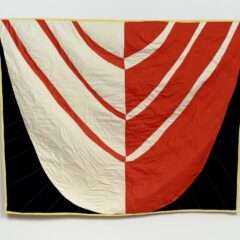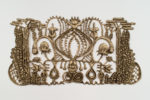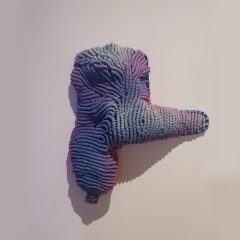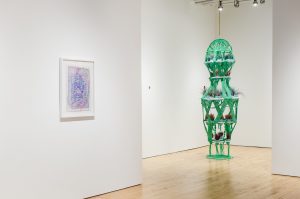“Four Decades” celebrates John Ollman’s captaincy of the blue chip gallery, Fleisher-Ollman. With some 90 works of drawing, painting and sculpture by acclaimed self-taught artists (and contemporary artists influenced by them) as well as antique craft works by native Americans and Pre-Columbians on display, the show is museum quality.
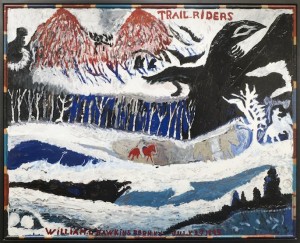
Ollman and the gallery were early champions of art by outsider artists (now called “self-taught”) and this exhibit demonstrates the appeal of the work. With bright colors, concrete imagery and often mesmerizing patterning, the works by these artists communicate as directly (and sometimes as subliminally) as advertising. This is narrative art, and whether the story the artist meant to tell is clear or not, the works communicate the urgency of the need to tell the story. These were not works worried over in the making with erasure marks in evidence – they poured out with confidence.
William Hawkins’ thick, muscular painting “Trail Riders,” from 1982, just one example, shows two tiny cowboys on horseback in a mountainous landscape. What sounds like a quintessential image of the American West is transformed by Hawkins into something moody, ominous and dream-like. With undulating horizontal stripes of blue, black and white as the land; huge black almost-abstract birds in the sky; and cartoonish twin red mountain peaks in the background, this work is a turgid piece that wears its makers dark vision as clearly as it wears his signature in big block letters at the bottom.
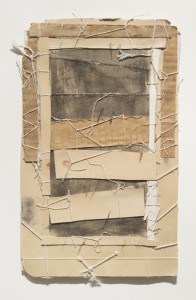
It’s great to see Hawkins, James Castle, Horace Pippin, Howard Finster and others represented in this mix. And the price list for the show (from modest 4-figure prices to astounding 6-figures for some works) demonstrates how the art world and the art market have embraced these once-marginal figures and now consider them essential to the history of art. It’s also great to see contemporary street artist Phil Frost in this mix. Frost’s installation “Open Heart Ascension” uses pattern painting to anoint and beautify a phalanx of found objects (nine glass water jugs and a hand-made pallet on which they sit). The piece complements the highly patterned native American works in the show and it relates well to James Castle’s decorative drawings on found scraps of paper and cardboard.
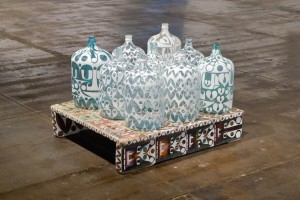
In a move that recalls the eccentric hodgepodge installations of Alfred Barnes, Ollman has set out some Pennsylvania Dutch decorative works (a chest, some Fraktur drawings) and Peruvian and Native American vessels in the gallery (see picture). The idea that art is a stream flowing through cultures and times, with universal human loves and concerns (nature, decoration, spirituality) is argued persuasively.
Ollman began his career at the Janet Fleisher Gallery at a time when employers advertised jobs in the newspapers and applicants hand-wrote cover letters to apply. In a nice touch, you can see Ollman’s application cover letter from 1970 in a small frame on the wall near the gallery office. It’s both history lesson and encouragement for anyone wanting to launch a career in a gallery today. Just put your hat in the ring, have some confidence, and give it a try. Good galleries steer a path into new waters and in recent years Fleisher-Ollman has become known for mining the local emerging artist scene. The gallery’s annual emerging artist invitational, coming this December, is another must-see exhibit.
>>”Four Decades,” to Nov. 22. Gallery talk by John Ollman, Nov. 13, 3 pm. Fleisher-Ollman Gallery, 1616 Walnut St., Suite 100. 215 545 7562.


